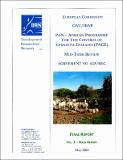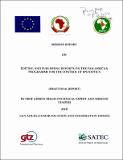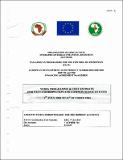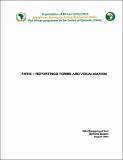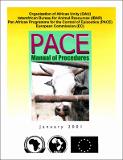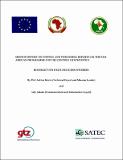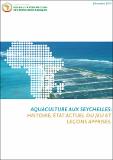Browsing Pan-African Programme for the Control of Epizootics (PACE) [1999-2007] by Issue Date
Now showing items 1-20 of 25
-
Pan-African Programme for the Control of Epizootic Diseases (Pace) Mid-Term Review Agreement No 6125/REG
(2003-05)The report presents the findings of the mid-term review (MTR) of PACE, the Pan African Programme for the Control of Epizootic Diseases. The MTR was undertaken in October-November of 2002 by a team assembled by ... -
Mission Report on Editing and Publishing Reports on the Pan-African Programme for the Control of Epizootics
(2007)A short term consultancy has been contracted by the German Technical Cooperation/International Service (GTZ/IS) — SATEC Developpement International and the African Union — Inter-African Bureau for Animal Resources (AU/IBAR) ... -
Work programme cost estimate for PACE coordination and common services unit.
The current document presents the activities of the PACE Coordination Unit (PCU) and the Common Services (CS) for the fifth Work Plan and Cost Estimate (WPCE) for a period of four months, from 14July 2004 to 314October ... -
Technical Assistance to Communication and PrivatisationLegislation.
Rinderpest was first introduced to the African continent in 1841 and it first appeared south of the Sahara in 1884, after infected cane were imported from India. The re salting epidemic killed over 90% of the indigenous ... -
Pan-African programme for the control of epizootics Ghana national project.
Ghana joined the international programme for the control of rinderpest code named Pan African Rinderpest Campaign (PARC) in 1992. At the end of PARC in March 1999, there were still important milestones in the OIE pathway ... -
Consolidated work programme and cost estimate for national PACE programmes of Burundi, Congo, Cote D`Ivoire, Ethiopia, Guinea Conakry, Kenya,Senegal, Sudan, Tanzania,Gambia.
The PACE strategy provides a framework within which national programmes will be developed and linked to sub-regional and regional strategies for the surveillance and control of the major epizootic diseases. The activities ... -
Global plan for PACE Eritrea 1st November 2000 to 31st October 2004.
Eritrea is part of the Horn of Africa and is located on the southern tip of the Red Sea coast of the continent covering an area of 124 432 sq. km. The country consists of arid and semi-arid lands made up of rugged mountains, ... -
Epidemiologist for the Collaborative Centres in Nairobi and N_Djamena.
Rinderpest was first introduced to the African continent in 1841 and it first appeared south of the Sahara in 1884, after infected cattle were imported from India. The resulting epidemic killed over 90% of the indigenous ... -
Paris - reporting's forms and visualization.
Summary report at national (for country database) and continental (continental database) level on the number of outbreaks, cases, deaths, morbidity rate and mortality rate per disease, for a particular month and cumulative ... -
PACE Kenya project first quarter progress report for year 2 annual work programme.
The second year workplan was approved in December, 2002. Despite the holiday season and national elections, project activities still continued during the quarter. Follow-up investigations of the suspected Laikipia rinderpest ... -
Annual work programme _ cost estimate for PACE Tanzania Year 2 (1st November 2002 to 31st October 2003).
This is a second Annual Work Plan and Cost Estimate for the PACE (Tanzania) Component which is part of the Regional Pan-African Programme for the Control of Epizootics (PACE) under the African Union Inter-African Bureau ... -
Provision of technical assistance to the national projects of the PACE Final report.
The Regional Technical Assistant, Dr. Nicolas Denormandie, was based at the Regional Coordination Unit of PACE in Bamako (Mali). He was covering initially seven French-speaking countries within Western and Central Africa, ... -
Pan- African programme for the control of epizootics (PACE) Kenya national project.
The PACE programme has the overall objective of contributing to rural development and poverty alleviation. This will be reached through effective disease control and animal he, care, which will secure the availability of ... -
Work programme _ cost estimate Nigeria national PACE programme for the period 1st May, 2002 to 30th April, 2003 (Year 2).
The Nigerian Pan African Rinderpest Campaign (PARC) project came to being through the preparation and approval of a work programme that was considered and endorsed by the Inter-African Bureau for .nimal Resources of the ... -
First year annual work programme and cost estimate Twelve (12) Months (2001- 2002).
The Pan-African Rinderpest Campaign (PARC) Kenya project work plan was signed in 1995 and implemented alongside the Emergency Programme for the Eradication of Rinderpest in Kenya (EPERK). The PARC project cost a total of ... -
Pan- african programme for the control of epizootics (PACE) First year annual work programme and cost estimate.
The Pan-African Rinderpest Campaign (PARC) Kenya project work plan was signed in 1995 and implemented alongside the Emergency Programme for the Eradication of Rinderpest in Kenya (EPERK). The PARC project cost a total of ... -
PACE Manual Procedures.
Animal health is a prior condition for the development of livestock farming and the rural world in Africa where, despite meat imports in particular, the population does not get proper amounts of animal protein. Animal ... -
Fourth Year work programme cost estimate for national PACE programme of Eritrea.
The PACE programme is funded by the European Development Fund in 32 Sub_ Saharan African countries for a period of four years. It is co-ordinated by the Inter African Bureau for Animal Resources of the Organisation of ... -
Booklet on PACE success stories.
When Rinderpest was introduced to Africa in the late 19th Century, the pandemic killed up to 90% of cattle and other susceptible wildlife species. The disease has plagued the African continent since then due to the presence ... -
Aquaculture Aux Seychelles: Histoire, État Actuel du Jeu et Lecons Apprises.
Le déclin des pêcheries de capture traditionnellement fiables et l’augmentation de la demande en matière de poissons aux Seychelles représente une préoccupation d’envergure en termes d’économie et de sécurité alimentaire. ...
